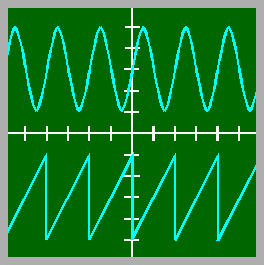oscilloscope
What is oscilloscope?
An oscilloscope is a laboratory instrument commonly used to display and analyze the waveform of electronic signals. In effect, the device draws a graph of the instantaneous signal voltage as a function of time.
A typical oscilloscope can display alternating current (AC) or pulsating direct current (DC) waveforms having a frequency as low as approximately 1 hertz (Hz) or as high as several megahertz (MHz). High-end oscilloscopes can display signals having frequencies up to several hundred gigahertz (Ghz). The display is broken up into so-called horizontal divisions (hor div) and vertical divisions (vert div). Time is displayed from left to right on the horizontal scale. Instantaneous voltage appears on the vertical scale, with positive values going upward and negative values going downward.
The oldest form of oscilloscope, still used in some labs today, is known as the cathode-ray oscilloscope. It produces an image by causing a focused electron beam to travel, or sweep, in patterns across the face of a cathode ray tube (CRT). More modern oscilloscopes electronically replicate the action of the CRT using a liquid crystal display (liquid crystal display) similar to those found on notebook computers. The most sophisticated oscilloscopes employ computers to process and display waveforms. These computers can use any type of display, including CRT, LCD, and gas plasma.
In any oscilloscope, the horizontal sweep is measured in seconds per division (s/div), milliseconds per division (ms/div), microseconds per division (s/div), or nanoseconds per division (ns/div). The vertical deflection is measured in volts per division (V/div), millivolts per division (mV/div), or microvolts per division (?V/div). Virtually all oscilloscopes have adjustable horizontal sweep and vertical deflection settings.

The illustration shows two common waveforms as they might appear when displayed on an oscilloscope screen. The signal on the top is a sine wave; the signal on the bottom is a ramp wave. It is apparent from this display that both signals have the same, or nearly the same, frequency. They also have approximately the same peak-to-peak amplitude. Suppose the horizontal sweep rate in this instance is 1 µs/div. Then these waves both complete a full cycle every 2 µs, so their frequencies are both approximately 0.5 MHz or 500 kilohertz (kHz). If the vertical deflection is set for, say, 0.5 mV/div, then these waves both have peak-to-peak amplitudes of approximately 2 mV.
These days, typical high-end oscilloscopes are digital devices. They connect to personal computers and use their displays. Although these machines no longer employ scanning electron beams to generate images of waveforms in the manner of the old cathode-ray "scope," the basic principle is the same. Software controls the sweep rate, vertical deflection, and a host of other features which can include:
- Storage of waveforms for future reference and comparison
- Display of several waveforms simultaneously
- Spectral analysis
- Portability
- Battery power option
- Usability with all popular operating platforms
- Zoom-in and zoom-out
- Multi-color displays